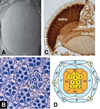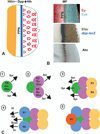Retinal differentiation in Drosophila
- PMID: 24014422
- PMCID: PMC3909661
- DOI: 10.1002/wdev.100
Retinal differentiation in Drosophila
Abstract
Drosophila eye development has been extensively studied, due to the ease of genetic screens for mutations disrupting this process. The eye imaginal disc is specified during embryonic and larval development by the Pax6 homolog Eyeless and a network of downstream transcription factors. Expression of these factors is regulated by signaling molecules and also indirectly by growth of the eye disc. Differentiation of photoreceptor clusters initiates in the third larval instar at the posterior of the eye disc and progresses anteriorly, driven by the secreted protein Hedgehog. Within each cluster, the combined activities of Hedgehog signaling and Notch-mediated lateral inhibition induce and refine the expression of the transcription factor Atonal, which specifies the founding R8 photoreceptor of each ommatidium. Seven additional photoreceptors, followed by cone and pigment cells, are successively recruited by the signaling molecules Spitz, Delta, and Bride of sevenless. Combinations of these signals and of intrinsic transcription factors give each ommatidial cell its specific identity. During the pupal stages, rhodopsins are expressed, and the photoreceptors and accessory cells take on their final positions and morphologies to form the adult retina. Over the past few decades, the genetic analysis of this small number of cell types arranged in a repetitive structure has allowed a remarkably detailed understanding of the basic mechanisms controlling cell differentiation and morphological rearrangement.
Copyright © 2012 Wiley Periodicals, Inc.
Figures






References
-
- Wolff T, Ready DF. Pattern formation in the Drosophila retina. In: Bate M, Martinez-Arias A, editors. The development of Drosophila melanogaster. Vol. II. Cold Spring Harbor: Cold Spring Harbor Laboratory Press; 1993. pp. 1277–1316.
-
- Ready DF, Hanson TE, Benzer S. Development of the Drosophil a retina, a neurocrystalline lattice. Dev Biol. 1976;53:217–240. - PubMed
-
- Wolff T, Ready DF. The beginning of pattern formation in the Drosophila compound eye: the morphogenetic furrow and the second mitotic wave. Development. 1991;113:841–850. - PubMed
-
- Tomlinson A, Ready DF. Neuronal differentiation in the Drosophila ommatidium. Dev. Biol. 1987;120:366–376. - PubMed
Publication types
MeSH terms
Substances
Grants and funding
LinkOut - more resources
Full Text Sources
Molecular Biology Databases
Miscellaneous

